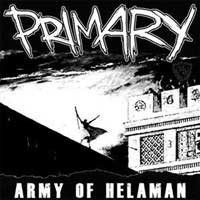The concept of this record is supernal. The execution is miraculous.
At first glance and listen, Primary's debut EP, Army of Helaman, is a standard crust punk thrasher. The eight songs on this seven-inch whiz by at a rapid pace. The entire record is coated in a thick grime, while down tuned guitars charge forward, bleeding into the other instruments, and molasses-and-glass vocals shred over the top of the near cacophony.
The record itself features distorted black and white photocopied images, using both apocalyptic themes as well as ancient icons. The jacket folds out into a larger poster, as was invented by Crass and Antisect.
But, upon further introspection, instead of songs about anarchy and future wastelands, each of the eight tracks is a song traditionally sung in Mormon primary school to educate children of the Mormon faith. In fact, each member of the band, which features members of Gnarboots, Boboso and Link 80, was raised in the Mormon faith and attended Mormon school.
But, what makes this release particularly interesting is that it seems to neither be an attack on the faith, nor an exaltation of it. As a general rule, crust punk seems to be anti-organized religion, and even resolutely atheist (But not alwaysâ¦). Rather, as the band tears through the tunes in a rapid fashion, the songs seem to be sung with genuine appreciation for both the craft and meaning of the songs. But certainly, Mormon elders would not be appreciative of their children's holy music being warped into a tar of rumbling drums, screeches and buzzing guitars.
Even more surprising is how good the songs turned out. Despite the disparate genesis of the genre and the source material, the pairing of the two shows the core strength of both. The religious songs show their inherent song craft in that when they are converted to dark, crushing attacks, the songs still sound as though they are calling to a higher power, showing that in their original form, there was no fat to be trimmed, and every word had value. Likewise, the sheer ability of crust punk to take holy music and so easily warp it into a sound of chaos and evil with just a little tinkering demonstrates the genres unique and wondrous aspects.
As one digs deeper into this release, much like the music, the purpose becomes even more and more murky. Is it a dark warping of the Mormon music, showing how easily it can be twisted? Is it a sneak attack Mormon attempt at converting the wicked by dressing up as a wolf, while remaining a sheep underneath? Much like only Joseph Smith could interpret the plates given to him by an angel, each individual listener will have to translate this as he or she will.
Random note: The label on this record features Demotic Egyptian, which is a late form of Middle Egyptian, which could be best described as a cursive slang of the language. However, translating the hieroglyphics using standard late Egyptian translation rules yields little more than gibberish. Is there a significance of Demotic Egyptian, or the Egyptian language at all, to the Mormon faith? Have I been derailed by yet another ambiguous trail?
